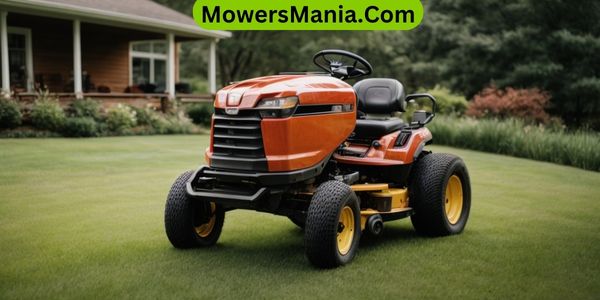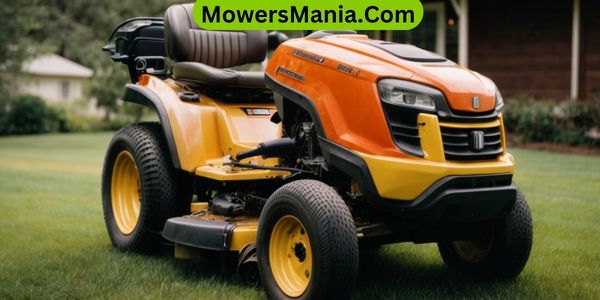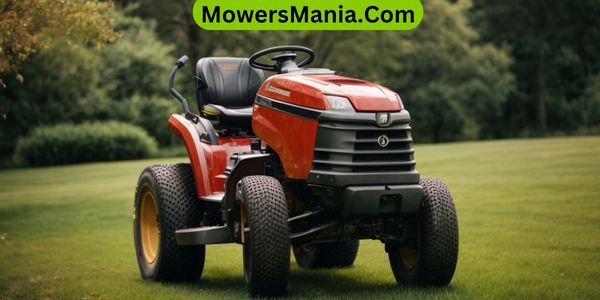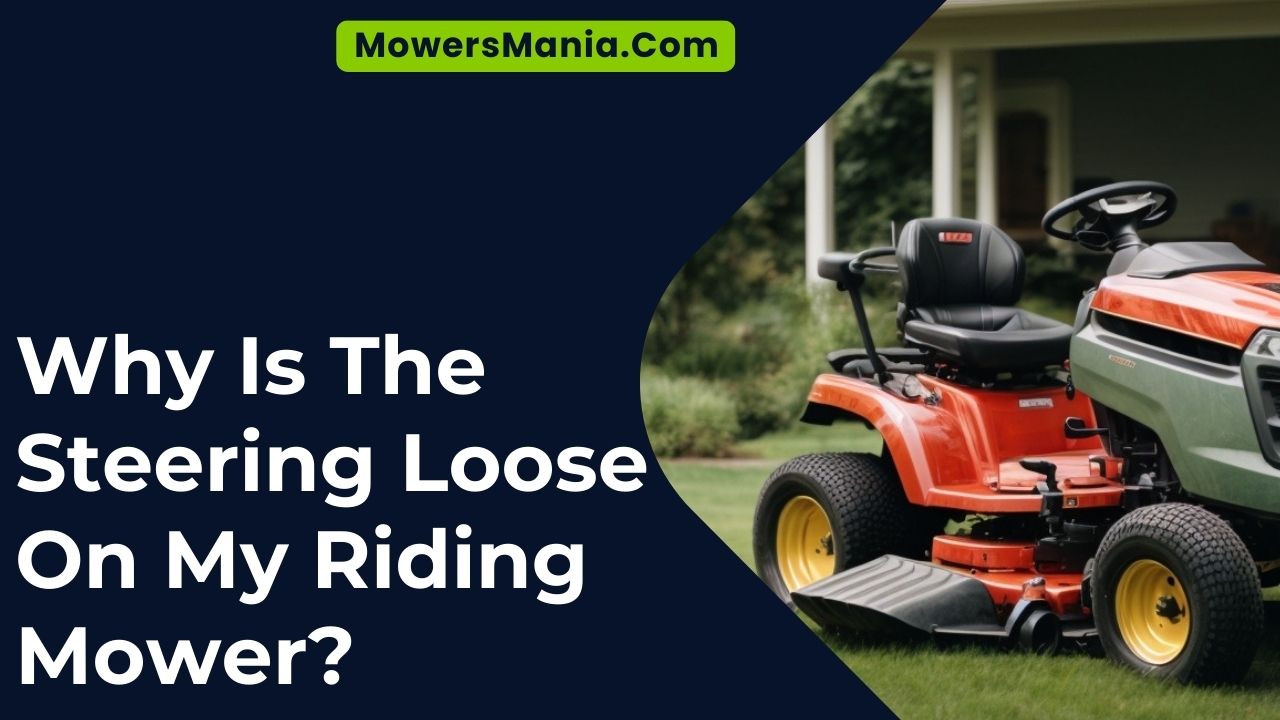Do you ever wonder why the steering on your riding mower feels loose?
There are common causes like wear and tear on steering components, improper wheel alignment, and low or leaking hydraulic fluid.

But don’t worry, there are solutions to tighten that loose steering and get your mower back in top shape.
Common Causes of Loose Steering
If your riding mower’s steering is loose, common causes can typically be traced back to issues with the steering components’ wear and tear.
One of the primary culprits for loose steering is the steering gear, which can become worn and develop excessive play over time. This can result in a noticeable lack of responsiveness when turning the steering wheel.
Additionally, the steering linkage, including the tie rods and ball joints, may experience wear and looseness, leading to a similar lack of control over the mower’s steering.
Another potential cause of loose steering is the steering wheel itself. If the steering wheel isn’t properly secured or if the steering column has excessive play, it can result in a loose feeling when attempting to steer the mower.
Furthermore, worn or damaged steering shaft components can contribute to steering issues, affecting the overall stability and control of the mower.
Regular inspection and maintenance of the steering components can help identify and address these common causes of loose steering before they lead to more significant problems. By promptly addressing wear and tear on the steering system, you can ensure safe and precise steering control of your riding mower.
Wear and Tear on Steering Components
Inspect the steering components for signs of wear and tear, particularly focusing on the steering gear, linkage, and shaft components. Over time, these parts can deteriorate due to regular use and exposure to various environmental conditions.
When assessing the steering gear, check for any excessive play or looseness in the gears, as this can indicate wear that may affect steering responsiveness.
Similarly, examine the linkage for any signs of bending, cracking, or rust, as these issues can compromise the integrity of the steering system.
Additionally, inspect the shaft components for wear, such as worn-out universal joints or damaged splines, which can contribute to a loose steering feel.
Keep an eye out for any worn or damaged bearings within the steering system, as these can lead to increased play in the steering mechanism.
Lastly, check for any signs of fluid leakage in power steering systems, as this can indicate wear and potential issues with the steering components.
Improper Wheel Alignment

When assessing the steering system of your riding mower, the first potential cause of loose steering to consider is improper wheel alignment.
Proper wheel alignment ensures that all four wheels are pointing in the same direction, allowing for smooth and straight movement. When the alignment is off, it can lead to erratic steering and excessive tire wear.
Check the alignment of your riding mower’s wheels using the following steps:
| Signs of Improper Alignment | What to Do |
|---|---|
| Uneven tire wear | Check tire pressure and adjust if necessary. Inspect for any obstructions or debris in the steering components. |
| Steering wheel off-center | Perform a visual inspection of the steering linkage and components for any signs of damage or excessive play. Adjust the tie rod ends if needed. |
| Drifting or pulling to one side | Inspect the steering wheel for any play or looseness. Tighten any loose components and ensure the steering mechanism is properly lubricated. |
| Excessive vibration | Check for any bent or damaged steering components. Replace any worn or damaged parts as needed. |
Low or Leaking Hydraulic Fluid
When your riding mower’s steering feels loose, it may be due to low or leaking hydraulic fluid, which can affect the performance and responsiveness of the steering system. Low or leaking hydraulic fluid can lead to several issues with your riding mower’s steering.
Here are some potential problems to look out for:
Solutions to Tighten Loose Steering

To address the issue of loose steering on your riding mower, the first step is to check and replenish the hydraulic fluid levels as needed. Low or leaking hydraulic fluid can cause the steering to feel loose or unresponsive.
Once you have ensured that the hydraulic fluid levels are adequate, you can proceed with additional steps to tighten the steering on your riding mower.
Below is a table outlining some common solutions to tighten loose steering on your riding mower:
| Solution | Description |
|---|---|
| Adjusting the Steering Gear | Tightening the steering gear can remove excess play in the steering, providing a more responsive control. |
| Checking and Adjusting the Tie Rod Ends | Ensuring the tie rod ends are properly adjusted and not worn can help eliminate any excess play in the steering. |
| Inspecting the Steering Shaft | Examining the steering shaft for any damage or wear and tear, and replacing it if necessary, can improve steering. |
Frequently Asked Questions [FAQs]
Can I Use Regular Automotive Steering Fluid in My Riding Mower’s Hydraulic System?
Yes, you can use regular automotive steering fluid in your riding mower’s hydraulic system. It’s compatible and will help maintain the steering system. Just be sure to check your mower’s manual for any specific fluid recommendations.
Is It Possible to Over-Tighten the Steering Components and Cause Damage?
Yes, it’s possible to over-tighten the steering components and cause damage. Always follow the manufacturer’s guidelines for tightening specifications. Pay attention to any unusual resistance when tightening, as this could indicate potential damage.
Are There Any Adjustments I Can Make to the Steering System to Improve Its Tightness?
You can adjust the steering system to improve its tightness. Check for any loose or worn components, and tighten or replace them as needed. Also, ensure that the steering linkage and gear assembly are properly lubricated for smooth operation.
How Often Should I Check and Maintain My Riding Mower’s Steering Components?
You should check and maintain your riding mower’s steering components at least once a season. This will help ensure that the steering remains in good working condition and can prevent issues like a loose steering.
Are There Any Safety Precautions I Should Take When Attempting to Tighten the Steering on My Riding Mower?
When tightening the steering on your riding mower, ensure the engine is off and the key is removed. Use the appropriate tools and follow the manufacturer’s guidelines to avoid injury. Always prioritize safety.
Conclusion
So, if you’re experiencing loose steering on your riding mower, it could be due to wear and tear on steering components, improper wheel alignment, or low hydraulic fluid.
To tighten the steering, you can inspect and replace any worn components, adjust the wheel alignment, and check and refill the hydraulic fluid as needed.
By addressing these issues, you can improve the steering performance of your riding mower and ensure safe and efficient operation.



